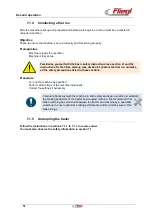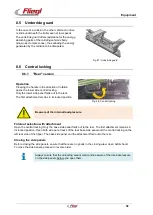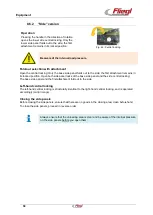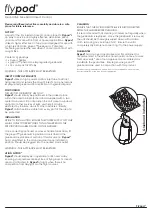
Use and operation
52
7.2 Working with the machine
7.2.1
General safety and operating instructions
The following section contains some general notes on safety and operation for working with the tandem
three-way tipper, repeated and summarized together for better clarity:
1.
The weights and loads specified on the type plate must be observed.
2.
Note the maximum permitted drawbar load of the trailer coupling.
3.
When parking the vehicle, make sure the supporting mechanism is correctly locked.
4.
Never
park the tandem three-way tipper on the supporting mechanism
while it is loaded
.
5.
Park the tandem three-way tipper so that it is stable. If the ground is soft, increase the size of
the support plate of the supporting foot.
6.
When parking the trailer, secure it against rolling away (parking brake, wheel chocks).
7.
The tandem three-way tipper must only be attached with the designated devices and in
compliance with regulations.
8.
Connect the brake system and check to ensure it is functioning properly.
Follow the manufacturer's instructions.
9.
There is a risk of injury when coupling/uncoupling the tandem three-way tipper to/from the
trailer.
Keep children away!
10.
When coupling, make sure that the trailer coupling pin is secured.
In the area around the tractor three-point linkage, there is a risk of injury at crushing or shearing
points.
11.
Before first-time start-up, move all protective devices to the safety position.
12.
Before coupling or uncoupling the vehicle, secure it against rolling away using the parking brake
and/or wheel chocks.
13.
The cylinder of the hydraulic draw gear must never be fully extended or retracted when driving.
Otherwise, the suspension will not function correctly.
14.
Movable structural parts, such as the side panel, must be secured in their end positions.
Special caution is required when opening and closing these parts.
15.
Move all devices to the transport position before driving on public roads.
16.
When performing maintenance work between the tipper bridge and the chassis, the stopcock for
the tipper hydraulics must be closed. This prevents accidental lowering of the tipper bridge.
(An optional bridge support can also be applied.)
17.
There must be
no
persons in the danger zone when the load is being tipped.
18.
Allow for reduced load on the tractor front axle and loss of steering ability due to the drawbar
load of the trailer.
19.
The tipping cylinder must be fully retracted when the trailer is not in use. Otherwise, moisture
may cause the cylinder to rust.
20.
Check that the Bowden cable (overrun brake) has ease of movement.
21.
Never reverse abruptly.
22.
Do not overheat the brakes! When driving downhill / uphill passes, make sure not to overheat
the brakes. After long and hard braking and riding over passes, the brakes must be allowed to
cool down.
23.
Always bring the tractor to a complete stop before selecting reverse gear.
Otherwise, the gas pressure damper in the overrun mechanism can break, causing severe
damage to the overrun mechanism.
















































